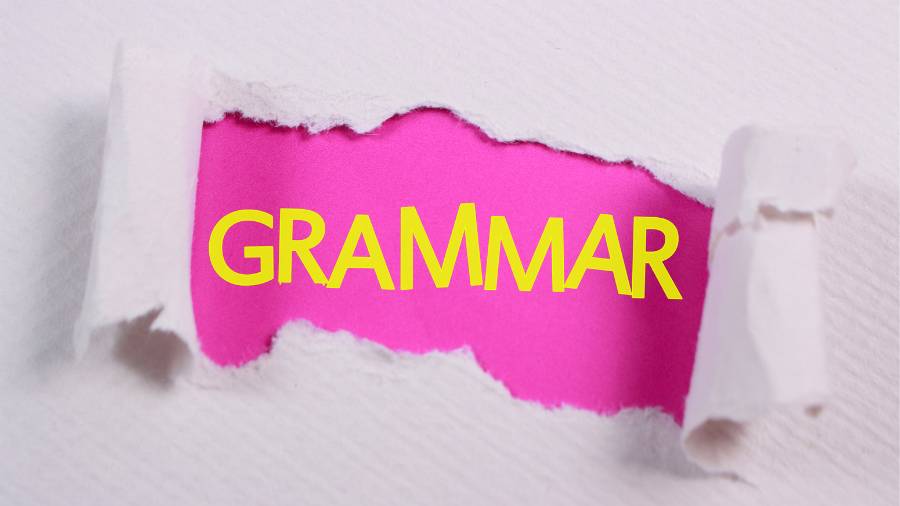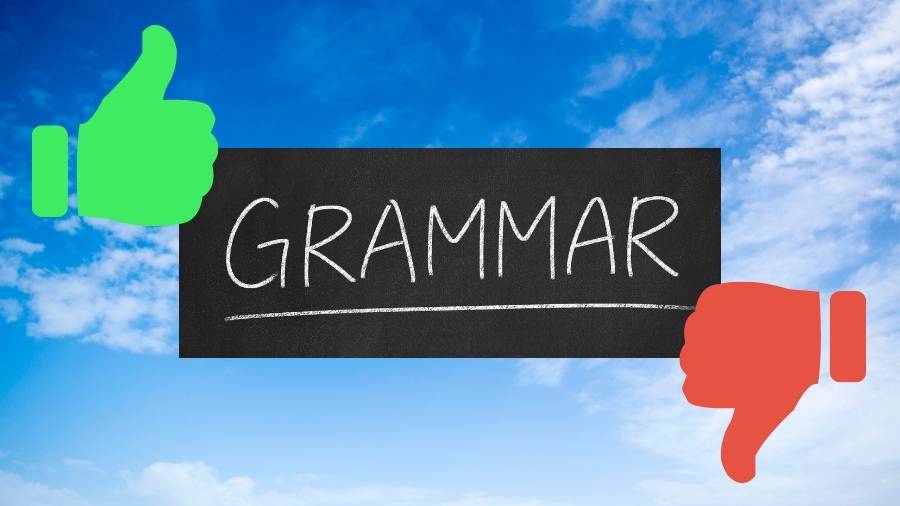This article may contain affiliate links. Please see our affiliate disclaimer in the footer menu for more information. Thank you for your support!

Grammar and usage are terms that arise when talking about language and writing. Good grammar and good usage are needed to communicate clearly. However, even though grammar and usage are closely related, they’re not the same.
Grammar is the set of rules that defines how words change their form and come together in a particular order to form sentences. Usage is how speakers of a language actually use words to communicate. Usage boils down to choosing the right word for the context.
Grammar rules remain relatively unchanged over time; however, usage evolves. Let’s delve deeper into the difference between grammar and usage and see why common usage doesn’t always equate to good usage.
Grammar vs. Usage: How Are They Different?
Let’s see an overview of how these terms differ.
Grammar vs. Usage
| Grammar | Usage | |
|---|---|---|
| Definition | how words (in various forms) are organized to make sentences | how a language’s speakers normally use words (based on their meaning) |
| Ease of Learning | requires some analysis | fairly easy to pick up on |
| Changes over Time? | very little | yes |
| Best Applied How? | style guide or grammar book | dictionary; usage guide within style guide or grammar book |
In a nutshell, grammar deals with how we combine the proper forms of words to make sentences. Usage is how speakers of a language use words to communicate.
Now let’s turn to a reputable dictionary to better understand what’s meant by grammar and usage before delving deeper into the differences.
A Working Definition of Grammar
The Merriam-Webster.com Dictionary defines grammar like this:
“the study of the classes of words, their inflections, and their functions and relations in the sentence”
Source: Merriam-Webster.com Dictionary
In this definition, the term classes of words refers to the different parts of speech.
The term inflections refers to how a word can change its form (e.g., take on a suffix) to alter its meaning or be used in a specific way.
For example, we can make a word plural by adding s.
And we can change the adjective verbose to the noun verbosity by adding the suffix -ity.
A Working Definition of Usage
Here’s how Merriam-Webster.com Dictionary defines usage:
“the way in which words and phrases are actually used (as in a particular form or sense) in a language community”
Source: Merriam-Webster.com Dictionary
Expert Opinions on How Grammar and Usage Differ
Here’s how the Merriam-Webster.com Dictionary explains the difference between grammar and usage:
“Grammar refers to the syntax, inflections, and structure of a language, whereas complaints about the misuse of the word irony would fall into the category of usage.”
Source: Merriam-Webster.com Dictionary
The Chicago Manual of Style, 17th Edition (CMOS), an esteemed style guide for US English, also clarifies the difference between these two terms.
“The great mass of linguistic issues that writers and editors wrestle with don’t really concern grammar at all—they concern usage: the collective habits of a language’s native speakers.”
Source: The Chicago Manual of Style, 17th Edition
To further clarify how grammar and usage differ, we’ll look at some sentences with grammar problems and others with usage problems.
But first, let’s see if usage falls under the umbrella of grammar.
Does Grammar Include Word Usage?

In the strictest sense, grammar does not include word usage. Grammar pertains to how words change their forms and how they are organized to make structurally sound sentences. Usage involves choosing words with the correct meaning given the context of a sentence.
CMOS is one of the best sources to confirm that these two terms differ.
The fifth chapter in CMOS is called Grammar and Usage. CMOS treats grammar and usage as two entities.
The part of the chapter dedicated to word usage contains a comprehensive subsection called the Glossary of Problematic Words and Phrases.
Many of the words in the glossary are homophones—words that sound the same but differ in meaning (and usually differ in spelling).
Here are a few examples of homophones taken from the glossary:
- accept and except
- its and it’s
- pedal and peddle
- waive and wave
Even native speakers get confused when it comes to homophones!
Are you ready to get a greater grasp on grammar? Let’s go!
What Is Grammar?
We now know that grammar deals with how words change their forms and how they’re placed in sentences in a particular order.
The words we use to construct sentences are divided into eight parts of speech:
1) Nouns (are a person, place, thing, or idea)
2) Pronouns (take the place of nouns)
3) Verbs (show action or state of being)
4) Adjectives (modify nouns)
5) Adverbs (modify verbs, adjectives, and other adverbs)
6) Prepositions (show the relationship that a noun or pronoun has with some other word in a sentence)
7) Conjunctions (join words, phrases, and clauses)
8) Interjections (express a strong emotion or reaction)
If you need help understanding these eight parts of speech, my post about grammar vs. punctuation shows how to use each part of speech in a sentence.
Another word you may hear in conjunction with grammar is syntax.
Syntax is the part of grammar that deals with the order in which we join words to form sentences.
Examples of Bad Grammar (and How to Make Them Good)

When people discuss good versus bad grammar, they’re talking about whether a sentence has followed standard grammar rules.
Here are a few sentences that break one of those golden grammar guidelines.
I apologize in advance if these sentences hurt your eyes. Some people are more averse to bad grammar than others. 😉
Example 1: A Pronoun Case Error
Bad Grammar: Between you and I, there seems to be something they’re not telling us.
This sentence breaks a grammar rule. The rule is that a pronoun that serves as the object of a preposition (like between) should be in the objective case, not the subjective (aka nominative) case.
An easy way to avoid this grammar goof is to temporarily switch the order of the pronouns you and I.
You wouldn’t say between I and you; you would say between me and you.
Then, just be sure to put the correct pronoun (me) after the pronoun you.
Putting yourself last in these kinds of constructions is the grammatically correct thing to do.
Now we can turn this lousy grammar situation around!
Good Grammar: Between you and me, there seems to be something they’re not telling us.
That was a bit of a complicated example, but I wanted to point it out since it’s such a common blunder.
Let’s see a more straightforward version of grammar gone wrong.
Example 2: A Mistake with the Past Tense
Bad Grammar: Yesterday, John goed to the store.

Since John went to the store yesterday, we need to use the past tense of the verb go. The past tense of go is went, not goed.
This blunder seems obvious to native speakers, but it’s not as obvious to non-native speakers since go is an irregular verb.
We usually change a verb to the past tense by adding the suffix -ed. We can form the past tense by changing walk to walked and talk to talked, but we can’t change go to goed.
Remember how our definition of grammar includes the word inflections?
Went is an inflection of the verb go.
Let’s correct the not-so-great grammar from above so that some people’s eyes can revert to their normal position. 😉 (Is anyone cross-eyed from that second example?)
Good Grammar: Yesterday, John went to the store.
Example 3: A Vague Pronoun Reference
Bad Grammar: Mary and Catherine loved seeing the movie that she had recommended.
Hmm. Does she refer to Mary, Catherine, or someone else? Who knows?
Let’s rewrite the sentence so that we know who she refers to.
Good Grammar: Mary and Catherine loved seeing the movie that Eloise had recommended.
Now we know who recommended that fantastic flick! 😊
I wrote an article about how to get better at grammar if you’re interested.
Now that we’re good to go with grammar, let’s upgrade our understanding of usage.
What Is Usage?

As we’ve seen, usage relates to how language speakers actually use words.
We also know that using a word to mean something that it doesn’t is a usage mistake. We can misuse just about any word if we think it means something it doesn’t.
However, it’s far more common to get confused with homophones (e.g., there, their, and they’re).
It’s also important to distinguish between what CMOS refers to as good usage versus common usage.
Dictionaries simply tell us how speakers of a language have used words over time.
And every so often, new words get added to the dictionary as they’re coined by speakers.
Nonetheless, just because a word is in the dictionary doesn’t necessarily mean that using it qualifies as good usage.
It may seem strange, but dictionaries aren’t tasked with pointing out the finer points of the English language; that duty is reserved for style guides like CMOS.
Let’s see some examples of improper vs. proper usage.
Examples of Improper Usage (and How to Correct Them)
Here are examples of improper vs. good usage.
Fun Fact: We have a term for using the wrong word in a given context: catachresis. 😊
Example 1: Eminent vs. Imminent
Improper Usage: They knew a storm was eminent because the clouds were dark gray.
Proper Usage: They knew a storm was imminent because the clouds were dark gray.
The word eminent means to stand above the rest in some respect. The term imminent refers to something (usually bad) that will probably happen soon.
Example 2: Stationery vs. Stationary
Improper Usage: He looked forward to exercising on his stationery bike.
Proper Usage: He looked forward to exercising on his stationary bike.
The word stationery refers to the special paper we use to write letters. Stationary means something that stays in place.
Top-Notch Tip: CMOS gives us a tip for differentiating between these two words: remember that both stationery and paper contain -er.
Example 3: Hanger vs. Hangar
Improper Usage: The airplane was kept safe in the hanger until they needed it for a flight.

Proper Usage: The airplane was kept safe in the hangar until they needed it for a flight.
A hanger is what we use to hang things on. A hangar is a shelter where aircraft are stored and repaired.
If you enjoyed these last few examples, feel free to try your hand at my homophone test toward the top of this article: “Top-Tier Proofreading Tests and Quizzes.”
Examples of Common Usage
Example 1: Gonna
I’m gonna give you one more example of common usage after this one.
The word gonna (a “pronunciation spelling” of going to) is in the dictionary. It’s a commonly used word that’s suitable for text messages, friendly notes, blog posts, and other kinds of informal writing.
However, even though it’s in the dictionary, it’s not considered good usage to include the word gonna in formal writing, like a business document, college term paper, or scholarly journal article.
Example 2: Ginormous
They have a ginormous swimming pool in their backyard!
You may be surprised to learn that ginormous is also in the dictionary. And yes, the word came about when people combined gigantic and enormous. 😊
Again, using this word in informal writing is accepted as common usage—it’s perfectly fine. However, a college professor would surely frown if a student used this casual term in a research paper.
An Example of Common Usage (but Not Good Usage)
You may be shocked by some of the words that have made their way into the dictionary.
The most shocking may be the word irregardless. Although many people think that irregardless isn’t a word, it is.
Here it is in the Merriam-Webster.com Dictionary.

You can see that the dictionary has included a usage note stating that the word is nonstandard.
Therefore, using the word irregardless is an example of common usage: some people use it. However, it’s not considered good usage.
Just because a word is in the dictionary doesn’t mean you should necessarily use that term.
“Remember that a definition is not an endorsement of a word’s use.”
Source: Merriam-Webster.com Dictionary
Common Usage: Irregardless of whether you like my outfit, I’m wearing it to the party.
If you refer to the Glossary of Problematic Words and Phrases in CMOS, you’ll see that using the word irregardless is considered an error. CMOS recommends using “regardless (or possibly irrespective)” instead.
Proper Usage: Regardless of whether you like my outfit, I’m wearing it to the party.
I hope this article has helped you differentiate between grammar and usage.
If you’d like to read a related article, feel free to check out “Grammar or Grammer: Which Is the Correct Spelling?”
Best wishes to you!
“Only those who attempt the absurd can achieve the impossible.”
– Albert Einstein

Recent Posts
Punctuation is important because it enables us to communicate our message clearly and effectively. Without punctuation, we wouldn’t understand how units of a sentence relate to one another or how...
Although you're probably somewhat familiar with adverbs, you may be unaware of sentence adverbs. As a trained proofreader who has studied the parts of speech, I can help you understand this unique...
